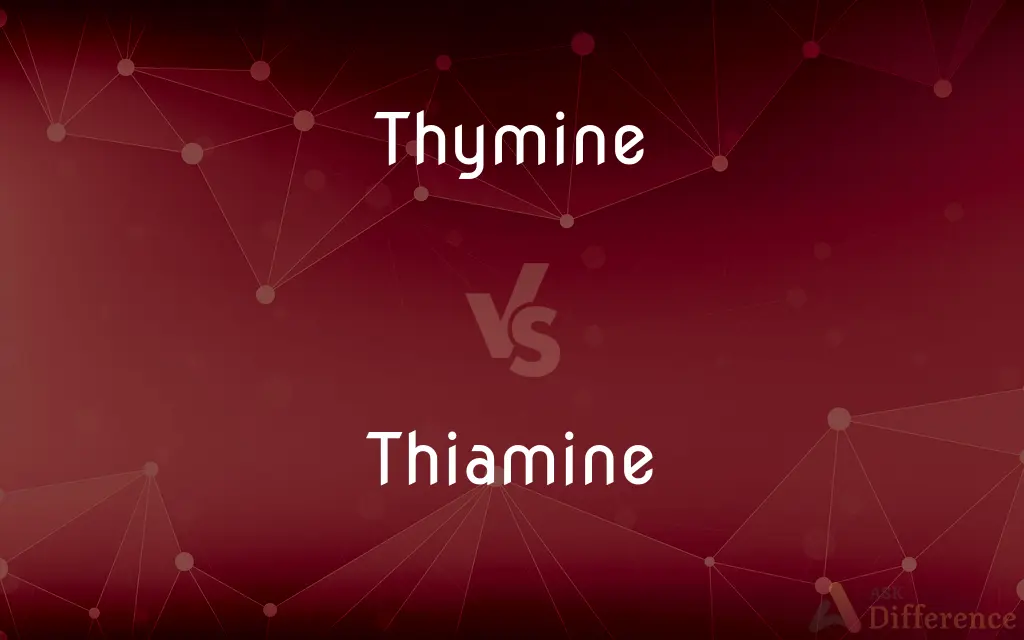Thymine vs. Thiamine — What's the Difference?
By Fiza Rafique & Urooj Arif — Updated on April 27, 2024
Thymine is one of the four nucleobases in the DNA molecule, crucial for genetic coding, while thiamine, also known as vitamin B1, is a vitamin essential for metabolism and nerve function.

Difference Between Thymine and Thiamine
Table of Contents
ADVERTISEMENT
Key Differences
Thymine is a pyrimidine nucleobase found in the DNA structure, where it pairs with adenine through hydrogen bonds, playing a critical role in the genetic stability and information transfer in organisms. Whereas thiamine, a water-soluble vitamin, participates actively in carbohydrate metabolism and is vital for the proper functioning of the nervous system.
In terms of molecular structure, thymine features a single-ring base that helps it bind with adenine, ensuring accurate DNA replication and repair. On the other hand, thiamine consists of a pyrimidine ring linked to a thiazole ring, enabling it to function as a coenzyme in several enzymatic reactions.
Thymine's role in biology extends primarily to its function within DNA, without which genetic disorders and errors in DNA replication could occur. While thiamine is crucial for energy production, particularly in nerve cells and other active tissues, its deficiency can lead to diseases like beriberi and Wernicke-Korsakoff syndrome.
The body's requirement for thymine is met through cellular processes and does not require dietary intake. Whereas thiamine must be obtained through the diet, with sources including whole grains, meat, and nuts, reflecting its essential nature.
Thymine abnormalities are generally related to DNA damage or mutation, impacting cellular function and organism health. In contrast, thiamine deficiency affects metabolic processes and nerve function, demonstrating a broader impact on general health.
ADVERTISEMENT
Comparison Chart
Type
Nucleobase in DNA
Vitamin (Vitamin B1)
Role in Body
Genetic coding and stability
Metabolism and nervous system function
Molecular Structure
Single-ring nucleobase
Pyrimidine and thiazole rings
Source
Formed endogenously in the body
Must be ingested through diet
Health Implications
DNA mutations and repair
Energy production and deficiency diseases
Compare with Definitions
Thymine
A nucleobase in DNA that pairs with adenine to form the genetic structure.
Thymine and adenine bonding is fundamental to DNA’s double helix structure.
Thiamine
Also known as Vitamin B1, essential for energy metabolism.
Thiamine is crucial for converting carbohydrates into energy.
Thymine
Crucial for the genetic integrity and replication process.
Mutations in the thymine base can lead to serious genetic disorders.
Thiamine
Acts as a coenzyme in various enzymatic reactions.
Thiamine pyrophosphate is a coenzyme form that plays a key role in the metabolism of sugars and amino acids.
Thymine
A pyrimidine derivative crucial for biological information storage.
Thymine’s stability helps maintain the accurate transmission of genetic information.
Thiamine
Needed for nerve function and brain activity.
Adequate thiamine levels are necessary to prevent neurological impairments.
Thymine
Involved in the cellular response to DNA damage.
Thymine dimers form as a result of UV radiation, leading to skin damage.
Thiamine
Commonly found in whole grains, meats, and nuts.
He added thiamine-rich foods like whole grains to his diet to improve his energy levels.
Thymine
Does not require dietary intake as it is synthesized by the body.
Thymine is produced by the cellular machinery and is not found in foods.
Thiamine
Deficiency can lead to beriberi or Wernicke-Korsakoff syndrome.
Thiamine deficiency is often seen in chronic alcoholics, leading to severe health issues.
Thymine
Thymine (T, Thy) is one of the four nucleobases in the nucleic acid of DNA that are represented by the letters G–C–A–T. The others are adenine, guanine, and cytosine. Thymine is also known as 5-methyluracil, a pyrimidine nucleobase.
Thiamine
Thiamine, also known as thiamin or vitamin B1, is a vitamin found in food and manufactured as a dietary supplement and medication. Food sources of thiamine include whole grains, legumes, and some meats and fish.
Thymine
A pyrimidine base, C5H6N2O2, that is an essential constituent of DNA.
Thiamine
A vitamin, C12H17ClN4OS, of the vitamin B complex, found in beans, whole grains, meat, and yeast, and necessary for carbohydrate metabolism and normal neural activity. Also called vitamin B1.
Thymine
A heterocyclic base, 5-methylpyrimidine-2,4(1H,3H)-dione; it pairs with adenine in DNA.
Thiamine
(vitamin) One of the constituents of vitamin B complex, found in meat, yeast and bran, that is necessary for the metabolism of carbohydrates.
Thymine
A base found in DNA (but not in RNA) and derived from pyrimidine; pairs with adenine
Thiamine
A B vitamin that prevents beriberi; maintains appetite and growth
Common Curiosities
Can thymine be ingested through diet?
No, thymine is synthesized in the body and does not need to be ingested through diet.
Is thiamine important for children and adults alike?
Yes, thiamine is vital for all age groups for proper metabolism and nervous system function.
What is thymine dimers?
Thymine dimers are a type of DNA damage caused by UV light where two adjacent thymine bases bond incorrectly.
How do thymine and thiamine interact in the body?
Thymine and thiamine do not directly interact; they serve different biological functions.
What are the primary functions of thymine and thiamine?
Thymine's primary function is in DNA structure and replication, while thiamine is essential for energy metabolism and nerve function.
How is thymine related to genetic disorders?
Abnormalities in thymine bases can lead to mutations, potentially causing genetic disorders.
Why is thymine critical in genetic coding?
Thymine's accurate pairing with adenine prevents mutations and ensures stable genetic information transfer.
Which foods are high in thiamine?
Foods high in thiamine include whole grains, meats, and nuts.
What are the symptoms of thiamine deficiency?
Symptoms include fatigue, irritability, reduced reflexes, and muscle weakness.
What are the consequences of thiamine deficiency?
Thiamine deficiency can lead to diseases such as beriberi and Wernicke-Korsakoff syndrome, impacting the nervous and cardiovascular systems.
What role does thymine play in UV radiation effects?
UV radiation can cause thymine dimers to form in DNA, which are lesions that can lead to skin damage and cancers.
What metabolic pathways require thiamine?
Thiamine is required in several pathways, particularly in the metabolism of carbohydrates and branched-chain amino acids.
How does thymine contribute to DNA replication?
Thymine pairs with adenine during DNA replication, ensuring accurate genetic coding and information transfer.
How can one prevent thiamine deficiency?
Consuming a balanced diet rich in thiamine sources like whole grains, meats, and nuts can prevent deficiency.
Can thiamine be synthesized in the human body?
No, unlike thymine, thiamine cannot be synthesized in the body and must be obtained through diet.
Share Your Discovery

Previous Comparison
Fume vs. Gas
Next Comparison
Interment vs. InurnmentAuthor Spotlight
Written by
Fiza RafiqueFiza Rafique is a skilled content writer at AskDifference.com, where she meticulously refines and enhances written pieces. Drawing from her vast editorial expertise, Fiza ensures clarity, accuracy, and precision in every article. Passionate about language, she continually seeks to elevate the quality of content for readers worldwide.
Co-written by
Urooj ArifUrooj is a skilled content writer at Ask Difference, known for her exceptional ability to simplify complex topics into engaging and informative content. With a passion for research and a flair for clear, concise writing, she consistently delivers articles that resonate with our diverse audience.














































